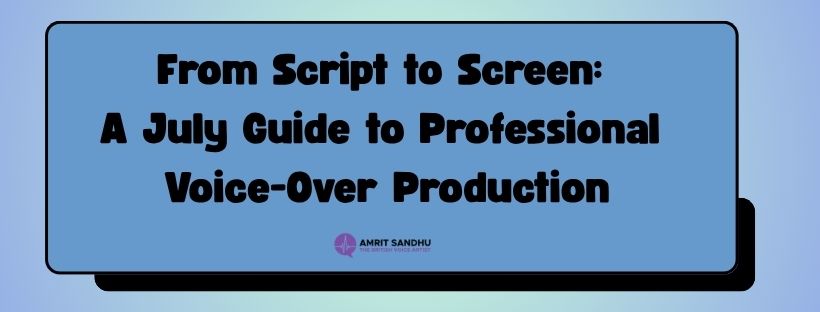The world of voice-over is a dynamic and rewarding field, offering creative freedom and the chance to lend your voice to a vast array of projects. But transforming a script into a polished, professional voice-over production requires more than just a good voice. It demands a meticulous process, encompassing technical expertise, creative interpretation, and a keen understanding of the client’s vision. This July, let’s delve into the comprehensive journey of professional voice-over production, from initial script analysis to final audio delivery.
I. The Foundation: Script Analysis and Preparation
Before a single word is spoken, the foundation of a successful voice-over lies in thorough script analysis and preparation. This phase is crucial for understanding the nuances of the script, identifying potential challenges, and crafting a performance that resonates with the target audience.
– Understanding the Client’s Vision:
The first step is to fully grasp the client’s objectives. What is the purpose of the voice-over? What message are they trying to convey? Who is their target audience? Understanding these aspects allows you to tailor your performance accordingly. This often involves reviewing the project brief, discussing the project with the client, and understanding the overall marketing or communication strategy.
– Deciphering the Script’s Nuances:
Once you understand the client’s vision, it’s time to delve into the script itself. Identify the tone, style, and emotion conveyed. Are you aiming for a friendly and approachable tone, a dramatic and powerful delivery, or something more subtle and informative? Analyze the vocabulary, sentence structure, and pacing. Pay attention to any specific instructions or notes provided by the client.
– Character Development (if applicable):
For narrative projects, character development is crucial. Consider the character’s personality, background, and motivations. How does their voice reflect their personality? Do they have a specific accent or dialect? Creating a believable character adds depth and authenticity to the performance.
– Identifying Potential Challenges:
Anticipate potential challenges, such as difficult pronunciations, technical aspects, or stylistic considerations. This proactive approach allows you to prepare accordingly and avoid unexpected hurdles during the recording process. This might involve researching unfamiliar terminology or practicing challenging phrases beforehand.
– Creating a Performance Plan:
Based on your analysis, develop a performance plan. This plan outlines your approach to the script, including pacing, tone, inflection, and emphasis. It acts as a roadmap for your recording session, ensuring a consistent and effective performance.
II. The Technical Aspects: Setting Up for Success
The technical aspects of voice-over production are just as crucial as the performance itself. High-quality audio is essential for a professional product.
– Choosing the Right Microphone:
Selecting the appropriate microphone is paramount. Condenser microphones are generally preferred for voice-over work due to their sensitivity and ability to capture a wide range of frequencies. Consider the type of voice-over project; different microphones are better suited for different applications.
– Optimizing Your Recording Space:
Your recording environment significantly impacts the quality of your audio. Choose a quiet space with minimal background noise. Use sound-absorbing materials to minimize reflections and echoes. A dedicated recording space is ideal, but even a well-treated closet can work wonders.
– Setting Up Your Recording Software:
Familiarize yourself with your recording software. Ensure your levels are properly set to avoid clipping or distortion. Use high-quality audio interfaces for optimal sound quality. Popular software options include Audacity (free), Adobe Audition, and Pro Tools.
– Monitoring Your Audio:
Use high-quality headphones to monitor your audio during recording. This allows you to identify any issues with your levels, background noise, or other technical problems in real-time.
III. The Recording Process: Bringing the Script to Life
The recording process is where the script transforms into a captivating audio experience. This phase demands focus, precision, and a commitment to delivering a high-quality performance.
– Warm-Up Exercises:
Before you begin recording, warm up your vocal cords with exercises to ensure optimal performance. This helps to prevent vocal strain and ensures a clear, consistent delivery.
-Multiple Takes:
Record multiple takes of each section to allow for selection of the best performance. This ensures that you capture the most natural and engaging delivery.
-Maintaining Consistency:
Strive for consistency in tone, pacing, and energy throughout the recording. Listen back to your takes regularly to ensure a cohesive and professional product.
– Dealing with Mistakes:
Don’t be discouraged by mistakes. They are a natural part of the process. Simply retake the section and move on.
IV. Post-Production: Polishing the Gem
Post-production is the final stage, where the raw recordings are polished to perfection. This phase involves editing, mixing, and mastering the audio to achieve a professional, high-quality product.
– Editing:
Edit your recordings to remove mistakes, pauses, and unwanted sounds. Ensure a smooth and consistent flow throughout the piece.
– Mixing:
Adjust the levels of your audio to create a balanced and clear sound. This might involve adjusting the volume, EQ, and compression of your voice.
– Mastering:
Mastering is the final stage, where the audio is optimized for distribution. This involves adjusting the overall loudness, dynamics, and frequency response to ensure the audio sounds its best across different playback systems.
V. Delivery and Beyond:
Sharing Your Work Once your audio is finalized, it’s time to deliver it to the client. This often involves providing different audio file formats to ensure compatibility with various platforms.
– File Formats:
Provide the audio in various formats, such as WAV, MP3, or AIFF, depending on the client’s requirements.
– Metadata:
Include relevant metadata, such as the project name, date, and your contact information.
– Feedback and Revisions:
Be prepared to provide revisions based on the client’s feedback. This is a collaborative process, and open communication is essential.
VI. Continuous Improvement: The Ongoing Journey
The world of voice-over is constantly evolving. To stay ahead of the curve, continuous learning and improvement are essential.
-Stay Updated:
Keep up-to-date with the latest industry trends, technologies, and techniques.
– Seek Feedback:
Regularly seek feedback from clients and other professionals to identify areas for improvement.
– Expand Your Skills:
Continuously expand your skillset by taking courses, attending workshops, and experimenting with new techniques.
VII. July’s Specific Focus: Leveraging Seasonal Opportunities
July, being a peak season for many industries, presents unique opportunities for voice-over artists. Consider specializing in projects related to summer promotions, vacation deals, or back-to-school campaigns. Tailor your marketing efforts to target these specific opportunities.
Conclusion: From Script to Screen, a Collaborative Endeavor
The journey from script to screen in voice-over production is a collaborative process requiring technical expertise, creative interpretation, and meticulous attention to detail. By mastering each stage, from script analysis to final delivery, you can elevate your voice-over work to a professional level, creating captivating audio experiences that resonate with audiences and leave a lasting impression. This July, embrace the challenge, hone your skills, and let your voice shine!




